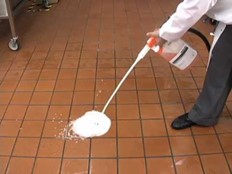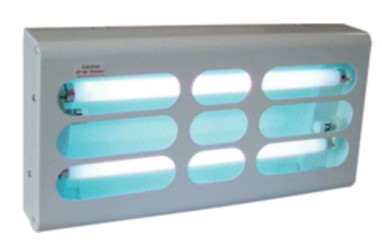
Integrated Pest Management
In Food Service and Restaurants
Pest Management Tools
Integrated pest management refers to the use of all viable controls that are available, whether they are chemical or non-chemical. The purpose of this newsletter is to introduce integrated pest management to our restaurateur customers.
Our goal at MD Weaver is to provide an educated and unbiased approach to pest management. With the restaurant environment, it is the German cockroach and the house mouse that cause the most concern, with the fly control being important as wells depending on the facility. Small flies such as the fruit fly (Drosophila), lesser fruit fly (D. repleta), drain fly (Psychodidae) and humpback fly (Phoridae) all can be a problem in drain systems and in areas where decaying food residue remains.
Rats usually involve a situation outside the premises; the larger American and oriental roaches are important in downtown areas. Programs are available for these as well. Additional programs are available in the summer for fly control. The following is a description of various tools employed in Restaurant PM. The most important keys are as follows:
Drain Treatment Program
Drains provide a source for the lesser fruit fly and other fruit flies. To supplement regular cleaning, drains can be included in a routine bacterial treatment that “digests” the sludge that supports the flies as a value-added MD Weaver service.

Fly Light Traps
It is always best to prevent flies from become adults or by excluding out of a facility in the first place. However, flies can enter occasionally and placement of adhesive, non-zapping fly light traps remove the flies and provide a monitoring tool to track activity.

Environmental & Sanitation
There is no substitute for proper site sanitation. Cockroaches thrive to the limit of their food, water sources, and places to hide. Also, placing toxic bait in cracks and crevices has been shown to be one of the most effective control measures, but is greatly hampered by food left easily available to the roach. One newspaper can house up to 7000 cockroaches. Paper goods and wooden products are especially attractive to German cockroaches. These potential domiciles must be regularly inspected and sorted through. Reducing clutter reduces the time required of the Pest Specialist.
Pest Exclusion
The German cockroach needs food, water, shelter, and climate. These are all part of the pest’s ecology, and the lack of any one of these will greatly affect the cockroach. Sealing off harborage areas is one the most important parts of cockroach prevention. Sealing cracks and crevices offers a permanent solution to a pest hiding problem.
Loosely constructed kitchen and bars provide a friendlier environment to German cockroaches than facilities that are kept in good repair and sealed up. A restaurateur with a clutter and sanitation problem in an aging kitchen may find roaches a continual issue, even with an up‑scale pest program. It pays to keep the environment non friendly to roaches. The professional pest specialist will work with the client on this issue. Caulking and sealing work can be provided with the pest service, and the client can be advised specifically on other improvements that need to be made.
Service Monitoring
Monitoring is made up of both a visual inspection and the use of glue insect monitors. Because of a German cockroaches’ limited travel, a commercial kitchen can be divided up into zones that can be tracked for roach activity. The visual inspection includes the use of a high intensity flashlight, and mirrors for looking around objects. Boxes and other items are moved around during the inspection to uncover potential hide-a-ways. At the conclusion of an inspection, the information is logged in a site notebook, and preferably shared immediately with the management.
Physical Control
An egg capsule carried by the mother German roach can contain up to 48 offspring. In general glue boards are considered important for monitoring, but also important as a control tool. Trapping is also important because a gravid (egg carrying) German cockroach does not eat for 8 days before laying the capsule and would not eat baits.
This is known as physical control for obvious reasons. Another physical control is the actual vacuuming up of cockroaches during the initial treatment of an infested restaurant. The pests are taken care of without the use of pesticides and cannot run anywhere before dying. The trapping of mice is a very important issue to mention and has a vital role in physical control. Both multiple catch metal traps and glue traps are available. The use of fly electrocution devices is another form of physical control.
Chemical Control
The judicious use of chemical pesticides plays an important part in pest management. When an active roach nest is located at any time, it can be treated with cockroach baits, supplemented with boric acid dust applications, and continually monitored with Insect Revealers®.
It is important that baits are applied where roaches can feed without being seen. By nature, this 6-legged pest seeks out cracks and crevices to spend most of its time. Therefore, cracks and crevices should be reduced by environmental controls, and the remainder used for baiting stations. Hollow voids such as wall interiors can be dusted with boric acid. It is relatively non-repellent and lasts a long time.
Tracking powders (a restricted use product) and baits play important roles in mouse and rat control. They must be used with care for maximum safety although they are very effective. Excluding rodents out of a facility and using multiple types of mousetraps should always be considered before using rodent toxins.
Documentation
A progressive pest control program includes thorough documentation. To record placement of bait and zone monitors, a schematic is kept with treatment and inspection sheets, in a Logbook. With the latest OSHA requirements, material safety data sheets and labels are maintained in the logbook as well. Pest control reports appease the health department in addition to giving important information to the client. Sanitation reports, provided confidentially to the client, point out things that can be addressed before a surprise board of health inspection.
Schedules
Initial Treatment:
A maintenance program begins with an initial treatment. The purpose of this work is to address any existing pest populations and to set up items such as traps, bait stations, and logbook. If there were an existing pest population, it would be reduced immediately and eliminated in 2 to 3 weeks after the start of work, pending the cooperation of the client. The amount for the service depends on the duration of visits and on the infestation, structure of the facility, etc.
Maintenance Program:
For prevention of future infestation by both insects and rodents, the I.P.M. program would include both chemical and non-chemical methods. The client would be updated regularly as to what conditions warrant their attention to prevent pest occurrences. Inspections would be made in accordance with the National Pest Management Association.